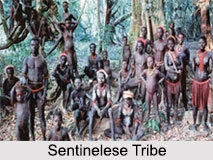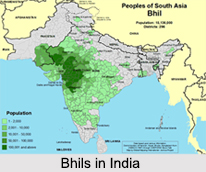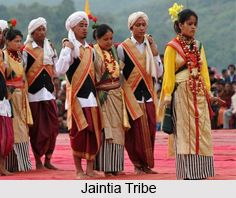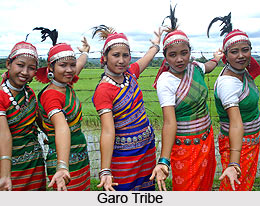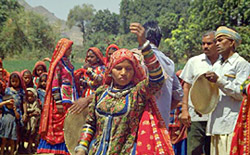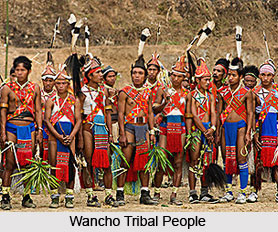 The Wancho Society is distinguished on the basis of class which are chiefly divided into four types each one of which is laid on the foundation of clan and sub-clan unity. The highest of the classes are the Wanghams, the Chief. He is authorised to all the perquisites of the society and even receives the honour and respect of the people. He serves as the principle figure around whom the tribal society revolves. The lowest class are the Wangpans or the commoners. In the middle are the Wangchas and the Wangchus. They have originated from matrimonial union between the two. The Wangchas have originated from the descendants of Wangham men and Wangpan women and are considered next to the Wanghams. The Wangchus are the children of Wangcha father and Wangpan mother who occupy the third strata in the social hierarchy.
The Wancho Society is distinguished on the basis of class which are chiefly divided into four types each one of which is laid on the foundation of clan and sub-clan unity. The highest of the classes are the Wanghams, the Chief. He is authorised to all the perquisites of the society and even receives the honour and respect of the people. He serves as the principle figure around whom the tribal society revolves. The lowest class are the Wangpans or the commoners. In the middle are the Wangchas and the Wangchus. They have originated from matrimonial union between the two. The Wangchas have originated from the descendants of Wangham men and Wangpan women and are considered next to the Wanghams. The Wangchus are the children of Wangcha father and Wangpan mother who occupy the third strata in the social hierarchy.
Family Pattern in Wancho Tribal Society
The Wancho family follow the patrilineal, patrilocal and patriarchal pattern. The father heads the family and exercises authority over all the family members. On becoming aged the father passes down the authority to the eldest son. The female members are engaged in the management of the household affairs.
The Wanchos follow the joint family system consisting of the father, mother and children and their daughter in laws. They all reside under the same roof sharing the same hearth. When there is insufficient place in the house to accommodate more people the married couples along with their offsprings shift to another household. The eldest son usually stays back to take care off their parents. The girls stay with their husbands after marriage. In case of the Chiefs, who generally have more than one wife, each wife has separate accommodation called Noi, where they take their meals separately. The Chief takes his meal with the chief wife called Wangsia. His meal is cooked by a particular wife called Chatonnu.
The system of division of labour is followed in the Wancho tribe. The male members of the family carry out the weighty works and the females are engaged in the lighter works of the household. Both the sexes work jointly for the agricultural and cultivation job. The husband and wife equally contribute towards child rearing and upholding the family values. The grown up boys are sent to dormitories called Morungs and the girls sleep in the houses of some widows not related by blood. The girls of the Chief`s family sleep in a separate compartment called Nausa-jip ham.
Kinship Pattern in Wancho Tribal Society
Wancho society follows the patrilineal pattern and the kinship pattern is traced through the patrilineal line. The kinship system recognizes the cognatic members, as well as affinal relatives. Most of the terms are applied to members of both cognatic and affinal relationships. Juniors are generally addressed by names. Care concern and responsibility of the tribal members towards each other depends on the degree of affinity and relationship. The kinship terms vary according to the dialectical variation among the different groups.
Inheritance and Succession in Wancho Tribal Society
In matters of inheritance and succession Primogeniture is the general rule followed by the Wanchos. The father of the family is the sole owner of it. Later after his death the property is transferred to the eldest son of the family who becomes the only authorised heir. Properties such as cultivable lands, bamboo groves and palm leaf gardens, livestock, granary, utensils, ornaments, hatchets and guns are held in common by the family. The female members have no claim over the family property though the articles girls bring during her marriage are considered her own personal property. Property belonging to the family cannot be sold or distributed without the permission of the family. During the time of establishing separate house by the married sons, apart the eldest one, the property is not divided. It can only be granted with the consent of the eldest son till the time the younger brothers starts earning.
At the time of establishing separate households they help with all the requirements including plots of land for cultivation. A girl can only carry the ornaments, clothings, one basket, one scraper, one iron stick, one hatchet and the rain shield made of grass, which are given to her at her marriage. Even the office of the Chieftainship is succeeded by the eldest son. Exceptional cases about property succession are decided by the village council.
Clan Organisation in Wancho Tribal Society
Each group of the Wanchos have a number of exogamous clans locally called jan. These clans can be addressed as lineage groups as they bear the names of the families and the ancestors from whom they have descended. They are named serially. The first name of a clan indicates the name of the ancestor, the second indicates the house and the last word means the group. The marriage system is regulated by the different clans and lineages of the Wancho. Descendents of each group closely identify themselves as relatives and many taboos and restrictions are observed in their behaviour.

















